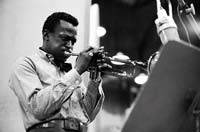
| Born: May 26th, 1926 in Alton, Illinois |
| Died: September 28th, 1991 (at age 65) in Santa Monica, California |
| Fields: Composer, Musician, Bandleader, Trumpet Player |
| Famous For: Being a leading jazz musician during his time |
| Awards: 9 Grammy Awards, Sonning Lifetime Achievement in Music, St. Louis Walk of Fame, Rock and Roll Hall of Fame, RIAA Quadruple Platinum |
Miles Davis was an American jazz musician, composer, bandleader, and trumpeter. He is considered to be one of the top 20th century U.S. musicians for his influence on the progress of the jazz scene. He was instrumental in the development of several new forms of jazz, including bebop, fusion, and modal jazz. In 2006, Davis was inducted into the Rock and Roll Hall of Fame.
Early Life
Davis was born in Alton, Illinois on May 25th, 1926. His family was both well-to-do and musical and when he turned 13, he received a trumpet from his father. He quickly demonstrated that his talent with the instrument was exceptional, leading to the first of many descriptions of him as a genius. He continued to specialize in playing the trumpet for the rest of his career, although his abilities were such that he was also able to perform with distinction on the keyboard and the flugelhorn.
Davis was educated in New York at the renowned Juillard School of Music. Here, he refined his musical techniques, allowing him to make his first recordings. These were in association with Charlie Parker, who had earlier been a colleague of Davis’s in the Billy Eckstine Band. By 1947, Davis was sufficiently well known to top a poll carried out by Down Beat, as well as making recordings with some of jazz’s legendary names, including Max Roach and Dizzy Gillespie.
Famous but Troubled
In 1949, Davis participated in a large-scale collaboration involving many excellent jazz musicians, including Kai Winding and Lee Konitz, together with Gil Evans the arranger. Davis had by now developed a style that was understated and refined, marking him out from his contemporaries in the bebop scene. Over the course of a little over a year, cool jazz was born. The sessions which led to this were finally produced as a set several years later: “The Birth of the Cool.”
By this time, Davis had become addicted to heroin, a problem that saw his musical career decline to no more than a few session performances. He cleaned up his act somewhat later in the decade, allowing him to restore his reputation and career. Again, he set out on a number of collaborations and released albums that are still considered jazz classics. “Kind of Blue,” “Porgy and Bess” and the self-titled “Miles Ahead” were all critically acclaimed.
Later Career
As the 1960’s dawned, Davis – now in his mid-forties – remained the most prominent innovator in jazz. During this period, he steadily increased the amount of electrified instruments in his groups, including not only keyboards but an electrified trumpet. Seeing the surging popularity of West Coast rock music, Davis felt that there was an opportunity to bring this genre together with jazz. His albums “Bitches Brew” and “In a Silent Way” are sometimes considered the first major jazz rock records.
In later life, Davis again became dependent on drugs, and more than once fell foul with the law. In 1975, he therefore decided that he should retire from active performing. Despite an intervening illness, he reversed his decision in 1981, when he released “The Man with the Horn.” He returned to the collaborations he had previously made so successfully, working with the likes of John Lee Hooker. He toured frequently around the world until near the end of his life, when his health would no longer permit him to travel. He died on September 28th, 1991.